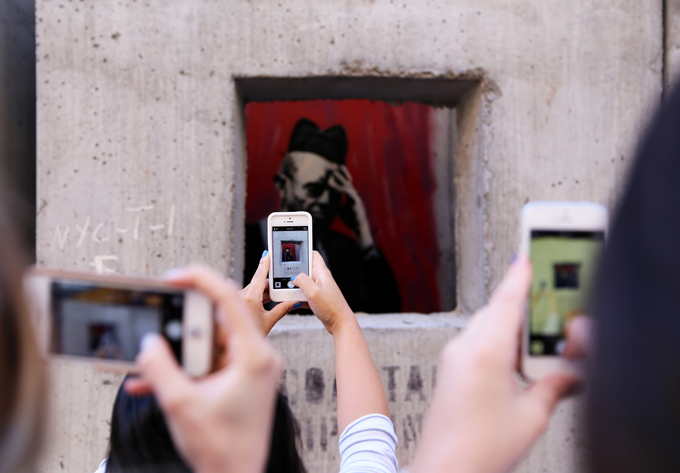
Banksy, Concrete Confessional, photographed at East 7th Street and Cooper Square, in Manhattan. Photo via flickr user carnagenyc, October 12, 2013.
On Sunday, a booth appeared in Central Park selling “signed,” “100% original” Banksys—at $60 a piece. Except for a few tourists, everyone ignored it. The booth seemed to be evidence of the cashing-in on any current event, from 9/11 to Occupy to a famous street artist’s “residency,” that we do in this most capitalist of cities. But it was real.
The internet lacerated itself for not buying Banskys at a 10,000-percent discount. But would you recognize art if it wasn’t marked as such? Banksy, who can’t write the word “elephant” on a water tanker without having it crated off and auctioned, made something that was fake until the magic moment it turned out to be real.
The Brand does transubstantiation. It turns crackers into the flesh of Christ.
Art’s market value, like that of fashion, is derived from name more than any material properties. The Chinese factory workers sewing Chanel handbags can make the same bags, after hours, but they’ll be low-rent knockoffs without the interlocking “C”s. The same goes for an assistant who painted, without the master’s imprimatur, Damien Hirst’s dots. The Brand does transubstantiation. It turns crackers into the flesh of Christ.
But Banksy accomplished something else when he sold his canvases in Central Park. Like graffiti artists, artists who sell on the street have an antagonistic relationship with the law. Under Mayor Giuliani, cops arrested them and confiscated their work, banning them from the plaza in front of the Metropolitan Museum of Art. Now they tangle with the police in Union Square. But while graffiti artists have benefited from the radical chic factor, the beau monde never hired street vendors to give them some rebellious cool. The vendors’ financial need is too clear. Cool is about not needing.
At a time when 1970s subway taggers are flown to Paris to mark up Louis Vuitton stores, Banksy is criticized for making money. “When you go to an art gallery, you are simply a tourist looking at the trophy cabinet of a few millionaires,” he wrote. And he’s right. In the world of galleries, artistic success means prices that rise until an artist’s audience is just bankers and oligarchs. Art’s radical social ambitions chafe against its economic realities. A gallery artist is a Fabergé egg maker pretending to be a revolutionary.
Banksy is a massively successful gallery artist. But, of all gallery artists, he’s one of the most skeptical. What some criticize as “spectacle” is really just refusing the model that ties exclusivity to success. Banksy might be selling rebellion. Still, with the profits, he’s able to rebel on a larger and more lacerating scale. Banksy takes the art world’s money, but he won’t buy its line.
For someone who loves art but to whom the art world sounds like babbling in an invented language, this is godsend. We don’t need the art world in order to love contemporary art, any more than we needed Parisian salons in order to love Manet. We don’t think of music critics when we dance till dawn, high and sweaty and in love.
For someone who loves art but to whom the art world sounds like babbling in an invented language, Banksy’s skepticism is a godsend.
“The quickest way to the top of your business is to turn it upside down,” Banksy wrote, during the time he was installing his work surreptitiously in the Louvre. Now, Banksy has become what’s called a brand. His stencils, skewed perspective and wit are recognizable enough to be mocked in The New Yorker. But branding is for cattle. If his table at Central Park was about anything, it was a mockery of brands themselves, of their numinous power over what we consider good.
And it’s a mockery of us for buying it. For not looking with our own eyes. For waiting for authorities to tell us what we can love.
Banksy can scribble a sentence on a wall and a month later it will be up for auction. But even Banksy can’t sell his work without the Banksy name.
This piece was jointly commissioned with The Guardian.

